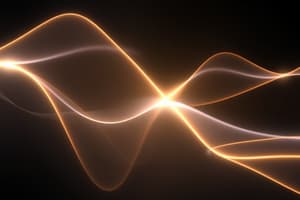Podcast
Questions and Answers
Which of the following are luminous?
Which of the following are luminous?
- Cloud
- Moon
- Sun (correct)
- Star
What is a source of light given off as a result of heating?
What is a source of light given off as a result of heating?
Incandescent
What is an idealized material that absorbs and emits electromagnetic radiation?
What is an idealized material that absorbs and emits electromagnetic radiation?
Blackbody
What term describes electromagnetic radiation given off from matter at any temperature?
What term describes electromagnetic radiation given off from matter at any temperature?
How does light interact with matter?
How does light interact with matter?
What is the term for materials that do not allow transmission of light?
What is the term for materials that do not allow transmission of light?
What is the term for light rays that travel in straight line paths?
What is the term for light rays that travel in straight line paths?
What do you call the image you see in the mirror?
What do you call the image you see in the mirror?
What happens during the refraction of light?
What happens during the refraction of light?
What is the ratio of the speed of light in a vacuum to the speed of light in a material?
What is the ratio of the speed of light in a vacuum to the speed of light in a material?
What part of the electromagnetic spectrum can our eyes detect?
What part of the electromagnetic spectrum can our eyes detect?
Who first studied the component colors of sunlight?
Who first studied the component colors of sunlight?
What is the term for the separation of white light into its component colors?
What is the term for the separation of white light into its component colors?
Polarization of light is best explained by considering it as what?
Polarization of light is best explained by considering it as what?
What occurs when light in one plane is transmitted while light in all other planes is absorbed?
What occurs when light in one plane is transmitted while light in all other planes is absorbed?
What effect is best explained by moving particles?
What effect is best explained by moving particles?
Who explained the photoelectric effect using Planck's work?
Who explained the photoelectric effect using Planck's work?
Today, light is considered to be what?
Today, light is considered to be what?
What do fiber optics transmit information using?
What do fiber optics transmit information using?
What is a luminous object?
What is a luminous object?
What describes an object that is hot enough to emit a dull red glow?
What describes an object that is hot enough to emit a dull red glow?
How can you see in shaded areas?
How can you see in shaded areas?
What is the term for an image not produced by light rays coming from the image?
What is the term for an image not produced by light rays coming from the image?
Any part of the electromagnetic spectrum can be measured in units of?
Any part of the electromagnetic spectrum can be measured in units of?
What does a prism do to the colors of sunlight?
What does a prism do to the colors of sunlight?
The phenomenon where light waves interfere is called what?
The phenomenon where light waves interfere is called what?
What discovery did Max Planck make regarding vibrating molecules?
What discovery did Max Planck make regarding vibrating molecules?
The polarization behavior of light can be explained by what?
The polarization behavior of light can be explained by what?
Today, light is considered to be what scale phenomenon?
Today, light is considered to be what scale phenomenon?
As the temperature of an incandescent light increases, what happens?
As the temperature of an incandescent light increases, what happens?
Is it possible to see light without light interacting with matter?
Is it possible to see light without light interacting with matter?
Of the following, which electromagnetic wave has the lowest energy?
Of the following, which electromagnetic wave has the lowest energy?
What does green grass reflect?
What does green grass reflect?
What does green grass absorb?
What does green grass absorb?
Why do we see a blue sky?
Why do we see a blue sky?
What visual effect occurs when a pencil is placed in a glass of water?
What visual effect occurs when a pencil is placed in a glass of water?
What is a one-way mirror designed to do?
What is a one-way mirror designed to do?
What causes a mirage?
What causes a mirage?
What does a glass prism do to sunlight?
What does a glass prism do to sunlight?
Why do Polaroid sunglasses work effectively in eliminating glare?
Why do Polaroid sunglasses work effectively in eliminating glare?
What lens can correct the condition of farsightedness?
What lens can correct the condition of farsightedness?
Today, how is light considered in terms of energy?
Today, how is light considered in terms of energy?
What is an instrument that produces a coherent beam of single frequency in phase light?
What is an instrument that produces a coherent beam of single frequency in phase light?
Flashcards
Luminous Objects
Luminous Objects
Objects that produce their own light, like the Sun.
Incandescent Light
Incandescent Light
Light generated from heat, like a lightbulb.
Blackbody
Blackbody
An idealized material perfectly absorbing and emitting electromagnetic radiation.
Blackbody Radiation
Blackbody Radiation
Signup and view all the flashcards
Light Interaction with Matter
Light Interaction with Matter
Signup and view all the flashcards
Opaque Materials
Opaque Materials
Signup and view all the flashcards
Incident Rays
Incident Rays
Signup and view all the flashcards
Virtual Image
Virtual Image
Signup and view all the flashcards
Refraction
Refraction
Signup and view all the flashcards
Index of Refraction
Index of Refraction
Signup and view all the flashcards
Visible Spectrum
Visible Spectrum
Signup and view all the flashcards
Dispersion
Dispersion
Signup and view all the flashcards
Polarization
Polarization
Signup and view all the flashcards
Photoelectric Effect
Photoelectric Effect
Signup and view all the flashcards
Quanta
Quanta
Signup and view all the flashcards
Albert Einstein
Albert Einstein
Signup and view all the flashcards
Photon Theory
Photon Theory
Signup and view all the flashcards
Fiber Optics
Fiber Optics
Signup and view all the flashcards
Color Reflection
Color Reflection
Signup and view all the flashcards
Blue Sky
Blue Sky
Signup and view all the flashcards
Refraction Illusion
Refraction Illusion
Signup and view all the flashcards
Mirage
Mirage
Signup and view all the flashcards
Prisms and Spectra
Prisms and Spectra
Signup and view all the flashcards
Wavelength Refraction
Wavelength Refraction
Signup and view all the flashcards
Polaroid Sunglasses
Polaroid Sunglasses
Signup and view all the flashcards
Farsightedness Correction
Farsightedness Correction
Signup and view all the flashcards
Lasers
Lasers
Signup and view all the flashcards
Temperature and Light Emission
Temperature and Light Emission
Signup and view all the flashcards
Light Perception
Light Perception
Signup and view all the flashcards
Study Notes
Luminous Objects
- Luminous objects produce their own light, e.g., the Sun.
- Incandescent light is generated from heat.
Blackbody Concepts
- A blackbody is an idealized material that absorbs and emits electromagnetic radiation perfectly.
- Blackbody radiation occurs when matter emits radiation at any temperature.
Light Interaction with Matter
- Light can interact with matter through reflection, refraction, and absorption.
- Opaque materials do not allow light to pass through.
Rays and Images
- Light is said to travel in straight paths called incident rays.
- A virtual image is formed when light rays appear to diverge from a location in a mirror.
Refraction and Indices
- Refraction occurs due to a change in the speed of light when transitioning between two transparent materials.
- The index of refraction is the ratio of the speed of light in a vacuum to the speed in a material.
Electromagnetic Spectrum
- The visible spectrum is the part of the electromagnetic spectrum that is detectable by human eyes.
- Sir Isaac Newton first studied the component colors of sunlight.
Light Properties and Phenomena
- Dispersion refers to the separation of white light into its component colors.
- Polarization involves light vibrating in a single plane and is best explained by considering transverse waves.
Photoelectric Effect and Quantum Theory
- The photoelectric effect is explained by the movement of particles, rooted in quantum theory.
- Max Planck developed the concept of quanta, which describes energy emissions in fixed amounts.
- Albert Einstein extended Planck's work to explain the photoelectric effect.
Photon Theory
- Light is viewed today as packets of energy known as photons.
- Fiber optics utilize light to transmit information efficiently.
Color Reflection and Absorption
- Green grass reflects green light while absorbing all other colors.
- The blue sky results from the scattering of light, which is more effective at shorter wavelengths.
Refraction and Optical Effects
- A pencil submerged in water appears bent due to refraction.
- A mirage occurs due to the refraction of light, creating the illusion of water in arid environments.
Prisms and Spectra
- Glass prisms separate sunlight into a spectrum because each wavelength refracts at different angles.
- Shorter wavelengths are refracted more than longer wavelengths.
Optical Instruments
- Polaroid sunglasses reduce glare by filtering out horizontally polarized light.
- Farsightedness can be corrected using a convex lens.
- Lasers produce coherent beams of light at a single frequency.
Temperature and Light Emission
- As the temperature of incandescent materials increases, more radiation is emitted at higher frequencies.
Light Perception
- Vision requires light to interact with matter; it's impossible to see light without this interaction.
Studying That Suits You
Use AI to generate personalized quizzes and flashcards to suit your learning preferences.
Description
This quiz features flashcards covering key concepts related to light from Chapter 7 of your physics textbook. Test your knowledge on topics such as luminous sources, blackbody radiation, and electromagnetic radiation. Perfect for mastering the fundamental principles of light and its interaction with matter.




